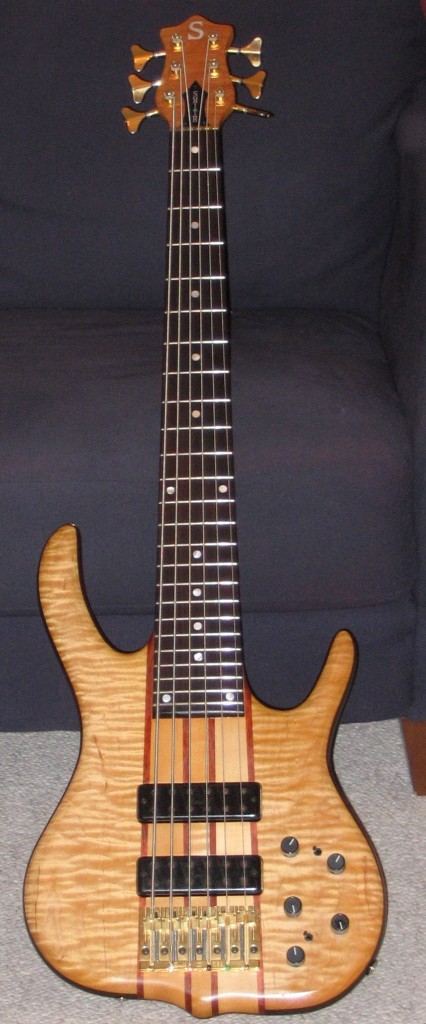Some of you may have noticed that I recently sold my only six string bass. It was a decision that has been creeping up on me for the last few years and suddenly seemed like an excellent idea.
I got the itch to start playing six just after finishing my music degree ten years ago. I switched to five at the end of high school, originally stringing my Warwick Corvette Proline with a high C string and a hipshot drop D tuner. I thought extending the range in both directions would be helpful. Shortly after getting the bass, I had a gig with a cover band that had a prominent low B part and opted to restring the bass in a more traditional manner, which immediately realized the utility of and never looked back. The low B has been indispensable, and though I’ve owned several four’s since then, I switched full time to five’s well over seven years ago, outside of my new Warwick Alien acoustic bass guitar which I doubt would produce enough low end to make a B string worth having. (It doesn’t leave the house much anyways.) It is worth noting that many gigs require a five string bass these days, such as work in theater orchestras at the Buell.

The six became of some interest to me after I had a resurgence in my interest in electric playing after spending most of music school consumed with upright bass, since it’s traditional focus on classical jazz music necessitated it. I was primarily interested in the six because of two players- Oteil Burbridge, and John Patitituci, whose stunning lyrical solos and chordal work was really making me reconsider what was possible with the electric bass. I took the plunge into a Ken Smith six by selling all of my other basses, and enjoyed the ability to solo in higher registers with some ease. It made the issues of string muting a more prominent issue, though, and the weight and size of the bass made me realize I needed to have something a little more playable for your average gig, and I quickly picked up another four.
It also garnered some dirty looks from a few of the blues and RnB musicians I was playing with, who wondered what I was going to be doing on some of the groove gigs. The reality was that while a low B can be helpful in almost any situation, high melodic solos on the C were not necessary for much of anything. Coming from a jazz background, I do solo a great deal for a bassist, but even then there were often many gigs that went by that I never found myself using that high C string on.
I picked up another modern five- an MTD 535- about three years ago, with the idea that it would take the place of my six on gigs where I wanted a contemporary sounding bass but wouldn’t be soloing much. It turns out that the six started spending much more time at home. I also started to become aware that when I wasn’t playing it regularly, my fingerboard knowledge of where the notes in high positions quickly diminished, and I often regretted not sticking with a five that I always knew so well. The crossover from URB was also diminished on the six, since there was less similarity between the two.
The other factor was that I have become increasingly picky about my sound the longer I play, and there was some part of me that was always disappointed with the tone of the high C string. It was very thin and had a much different character that the other strings, and as a player who often is going for a full bodied tone, I found I preferred the sound of the G string in very high positions to the C string in middle ones. I never used the C for bass lines, and rarely played it below the 10th fret, preferring to treat the bass like I would a four with an option to cross to the high string only when I wanted a different sound for soloing. I also realized I rarely used those last five frets on the C that actually extend the range of the bass.
Another issue that I wish more of my students would also consider is the challenge of playing multiple basses and styles of music. Between playing jazz and classical music on the URB, fretless, and regular five, the six was an auxiliary skill that often got pushed aside in favor of more essential skills. I enjoy playing in many genres and using different instruments, but there is always the opportunity cost that one’s respective skill on each is more slowly developed. I realized that while playing arco and fretless were skills that often got me working gigs and were commented on by audiences and my fellow musicians, no one was requesting the six or telling how much the enjoyed it. I decided that it was time to let that less essential skill go in order to focus on doing the things that I knew I really wanted to do well at the highest level possible.
So for the time being, I’m retiring the six. It is entirely possible that I will hear a six player and want to take it up again in the future, but for now I’m going back to the more manageable five with the hope that my skills there will be more than enough while soloing that no one will remember I played six for a decade of my career. We shall see . . .

It was nice meeting you , nice website, wow.
Thanks Matt! Welcome to town.
I have played 4 5 and 6 string bass. The 4 is good for slap and ease of use due to simplicity, and I will use it generally. The 5 is a life saver for my current bands – 1 is a prog metal band in low C, the other is a covers band which plays songs in strange keys. Playing walking bass lines in e flat is certainly easier with the extra string! Used to play a 6, enjoyed the higher string for harmonics and chords, and was good to play at home alone, however in a band I don’t think the high C is required really. I also like being forced to do more with less – five strings are enough.
My two cents.
Andy,
Exactly my experience with things! I may get a six again someday for home, but for now it’s all 5’s. Thanks for your comment.